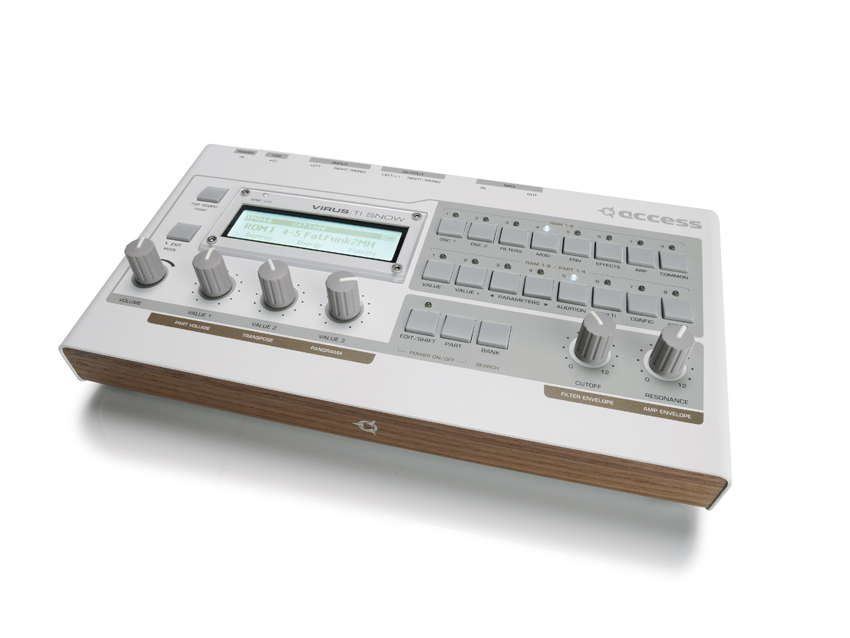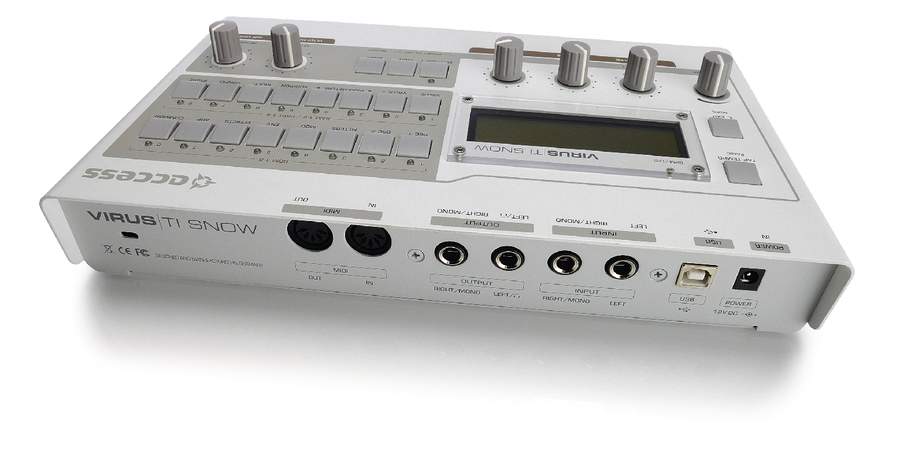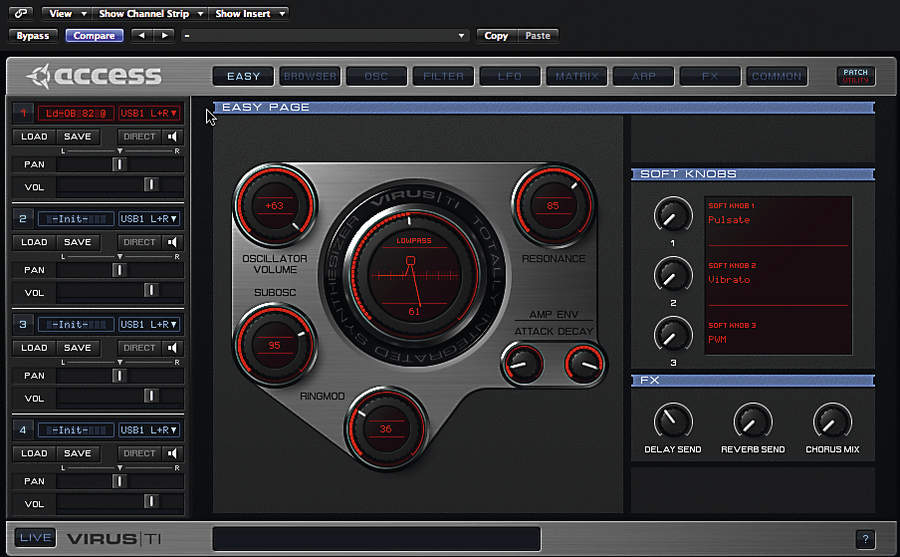MusicRadar Verdict
It´s the Virus you´ve always dreamed about: sleek, sexy and offering that famous sound for a reduced price.
Pros
- +
Compact size but enormous sound. Very little compromise on features. TI software integration is wonderful.
Cons
- -
Not as much hands-on control as its big brothers. Still fairly pricey.
MusicRadar's got your back



The Virus TI enjoyed huge success, but the original members of the family - the Desktop, Keyboard and Polar models - are pricey. So, we now have this more affordable addition to the clan, the TI Snow.
Casting an eye over the Snow, the first thing you notice is that the design tradition of previous Viruses is gone - this is a much more compact unit. The 'wedge' shape has morphed into a trapezium, and the Snow is only two-thirds (or so) the size of its bigger brothers.
In terms of styling, the front edge is a rather classy wooden panel with the Access Logo proudly stamped in the middle. The colour scheme is lifted from the Polar, so there's a cream panel and brown legending, complete with bright white LEDs.
Overview
The most significant implication of the reduction in size is the number of front-panel knobs, which is dramatically smaller than on the full Desktop TI. Just six rotating dials adorn the bottom row of the panel, one of which is master volume.
Above these, function and value buttons enable access to the Snow's inner workings, while a generous, bright LCD screen keeps you in touch with parameters, names and values.
The back panel is pared down too, with stereo jack inputs and outputs, MIDI In/ Out and the all-important USB port.
Fortunately, very few compromises have been made with the inner workings of the instrument. The Snow retains almost all the full TI sound engine and is sonically comparable to its siblings.
The main restriction is that the Snow is only four-part multi-timbral, but this isn't too much of a drawback, as most Virus users are used to running out of polyphony long before they run out of parts!
The Snow's polyphony is more restricted than that of its siblings, with 50 voices estimated as a maximum. With this in mind, there's a section in the manual that explains how the Virus uses its voice allocation and how it's possible to analyse the selected sound to see whether polyphony is running as economically as possible.
One small 'physical' frustration is that the left-hand (mono) output doubles as the headphone port. This seems a bit stingy - what if you need to use both at once?
The sounds
The Snow offers lots of sounds - eight banks of 64 in total. These are split, half and half, into RAM and ROM banks, though the lines have blurred here with the release of the latest OS, as both types can now have their memories overwritten.
Selecting sounds directly from the front panel is painless enough - you simply click the Bank button, select the bank you want, and then choose one of the 64 sounds via the two rows of eight buttons.
Alternatively, if you're in full TI mode, with the Snow slaved to your computer via the USB port, choosing sounds is even easier, as a dedicated Browser exists for each of the four parts, enabling you to wade through the list, or narrow your search field to dedicated groups of sounds. Double-clicking launches your selection and then provides access to the software implementation of your chosen sound
If you're working multitimbrally, you can then simply move down to the second instrument and start choosing all over again. Alternatively, if you're sound selecting on the Snow's front panel, a dedicated Part button ensures you won't get lost.
Sonically, there's something for everyone here. The Snow is capable of subtle and gentle sounds, but don't make it mad, for it has a penchant for sheer, unadulterated brutality too!
Editing
The diversity of the onboard sounds is down to the Virus' multi-pronged approach to synthesis. While there's a rich seam of traditional analogue-style oscillators, there are also FM generators, granular synths and even the opportunity to route live audio into the Snow. If you have an appetite for sound design, this is a wonderful instrument.
With the pared-down front panel, you might expect sound editing to be compromised and, to a point, you'd be right. While knobs are provided for filter cutoff and resonance, the rest of the parameter-tweaking is mostly left to the buttons.
The upper row matches the software editor to an extent in that you can jump directly into the structure section you're intending to tweak before adjusting values with the row of buttons below. Additionally, three assignable soft dials are provided below the LCD, which you can configure to modify the parameter of your choice
Here then, is a chance to modify effects parameters, frequency modulation amounts, envelope lengths… anything you like, really.
As ever, once you've got used to them, lots can be achieved with the dials, but this is where Access has taken its gamble. If you want more hands-on control, you'll need to fork out for the Desktop TI; if you're happy having the sound engine and full software integration, the Snow's for you.
We think the provision of the three dials is possibly with live tweakers in mind - there are just about enough to ensure you can significantly modify sounds in real-time and little danger that you'll get lost searching for the right dial at the critical moment. And as the current parameters are displayed on screen directly above the knob to which they're assigned, working in low-light conditions won't be a problem either.
Summary
It's clear that the Snow is aimed primarily at those who are excited at the prospect of being able to integrate the stunning Virus sound engine into their DAW setup and are willing to sacrifice some of the Desktop TI's hands-on immediacy. Access has worked hard to make sure that all the sound-shaping functions are available with a minimum of key-presses, but it also knows that nothing beats being able to reach out for a dedicated dial and give it a good tweak.
The Snow still isn't exactly cheap, but that's because the core Virus TI synth engine remains intact. The fact is that you can now add the Access sound to your setup for hundreds of pounds less than before, and that's got to be something worth celebrating.
Want to hear the Virus TI Snow in action? Listen to the following clips:
For a more in-depth review of the Virus TI Snow, check out issue 199 of Future Music
MusicRadar is the number 1 website for music makers of all kinds, be they guitarists, drummers, keyboard players, djs or producers...
GEAR: We help musicians find the best gear with top-ranking gear round-ups and high- quality, authoritative reviews by a wide team of highly experienced experts.
TIPS: We also provide tuition, from bite-sized tips to advanced work-outs and guidance from recognised musicians and stars.
STARS: We talk to musicians and stars about their creative processes, and the nuts and bolts of their gear and technique. We give fans an insight into the actual craft of music making that no other music website can.
“I have an original 909 – every time I try to use it I feel like I’m ruining it”: House hero Riva Starr on his studio essentials and his love of analogue synths
“A synthesizer that is both easy to use and fun to play whilst maintaining a decent degree of programming depth and flexibility”: PWM Mantis review
“I feel like that song had everything we needed to come back with”: Bring Me The Horizon’s Lee Malia on Shadow Moses, its riff and the secrets behind its tone, and why it was the right anthem at the right time










